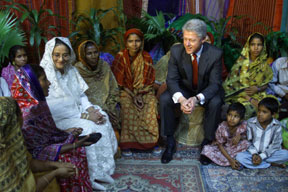Microcredit facts for kids

A microcredit is a very small loan given to people who want to start or grow a tiny business, especially in developing countries. These loans are often called micro-loans. The main idea behind microcredit is to help people become entrepreneurs and fight poverty. Many people who get microcredits cannot read or write well, so they can't fill out the forms needed for a regular bank loan.
Microcredits work a bit differently from normal bank loans. The money borrowed is usually a small amount. The interest rate, which is the extra money you pay back, can be higher than for a regular loan, sometimes over 20%. Also, people often have to pay back the loan more often, like every week or month. Some people worry that microcredits can lead to problems if people can't pay back their debt.
Contents
What is Microcredit?
Microcredit is a way to give very small loans to people who are poor. These loans are usually for starting or improving a small business. For example, someone might borrow money to buy a sewing machine to make clothes. Or they might buy tools to fix things. The goal is to help people earn money and improve their lives.
Why Microcredit Helps People
Many people in developing countries do not have access to regular banks. They might not have enough money to open an account. Or they might not have the right papers to get a loan. Microcredit programs offer a chance for these people to get the money they need. This helps them start small businesses and become more independent. It also helps their families and communities.
The History of Microcredit
The idea of microcredit became popular thanks to a man named Muhammad Yunus. He is from Bangladesh. In 1976, he started the Grameen Bank. This bank was one of the first to give small loans to poor people without needing collateral. Collateral is something valuable you promise to give the bank if you can't pay back your loan. Muhammad Yunus won the Nobel Peace Prize in 2006 for his work with microcredit.
How Microcredit Works
Microcredit loans are usually very small. They are much smaller than loans from big banks. The money is often used for things like buying materials for crafts. Or it might be used to buy food to sell in a market. The loans are designed to be simple. This makes them easy for people to understand and use.
Repaying Microloans
People who get microloans usually pay them back in small amounts. They might pay back a little bit each week or month. This helps them manage their money. It also makes it easier to pay back the loan on time. Sometimes, groups of people get a loan together. If one person struggles to pay, the others in the group might help. This encourages everyone to be responsible.
Challenges of Microcredit
While microcredit helps many, it also has challenges. The interest rates can be high. This means people pay back a lot more than they borrowed. If a business does not do well, people can struggle to repay the loan. This can lead to more debt. It is important for microcredit programs to be fair. They need to make sure people can really benefit from the loans.
Images for kids
-
Nobel laureate Muhammad Yunus, the founder of Grameen Bank, which is generally considered the first modern microcredit institution
See also
 In Spanish: Microcrédito para niños
In Spanish: Microcrédito para niños





